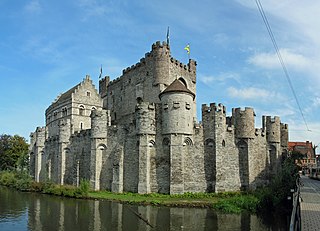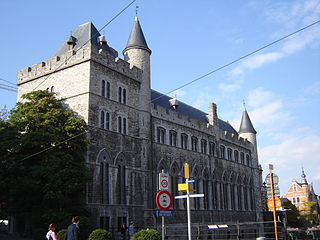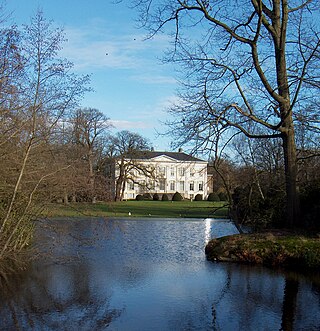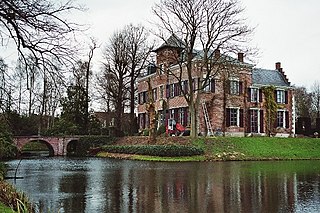
Heusden is a municipality and a city in the south of the Netherlands. It is located between the towns of Waalwijk and 's-Hertogenbosch. The municipality of Heusden, including Herpt, Heesbeen, Hedikhuizen, Doeveren, and Oudheusden, merged with Drunen and Vlijmen in 1997, giving the municipality its current form.

Heusden was a municipality located in the Belgian province of East Flanders. In 1977 it merged with the municipality of Destelbergen, of which it is now part.

The Gravensteen is a medieval castle in the city of Ghent, East Flanders in Belgium. The current castle dates from 1180 and was the residence of the Counts of Flanders until 1353. It was subsequently re-purposed as a court, prison, mint, and even as a cotton factory. It was restored over 1893–1903 and is now a museum and a major landmark in the city.

A keep is a type of fortified tower built within castles during the Middle Ages by European nobility. Scholars have debated the scope of the word keep, but usually consider it to refer to large towers in castles that were fortified residences, used as a refuge of last resort should the rest of the castle fall to an adversary. The first keeps were made of timber and formed a key part of the motte-and-bailey castles that emerged in Normandy and Anjou during the 10th century; the design spread to England, Portugal, south Italy and Sicily. As a result of the Norman Conquest of England in 1066, use spread into Wales during the second half of the 11th century and into Ireland in the 1170s. The Anglo-Normans and French rulers began to build stone keeps during the 10th and 11th centuries, including Norman keeps, with a square or rectangular design, and circular shell keeps. Stone keeps carried considerable political as well as military importance and could take a decade or more to build.

The Château de Sully-sur-Loire is a castle, converted to a palatial seigneurial residence, situated in the commune of Sully-sur-Loire, Centre-Val de Loire, France.

While there are many castles in South Yorkshire, the majority are manor houses and motte-and-bailey which were commonly found in England after the Norman Conquest.

Egmond Castle, also called the Ruins of Egmond, is a ruined medieval castle in the Dutch province of North Holland. It is located in Egmond aan den Hoef in the municipality of Bergen and lies about 7 kilometres (4.3 mi) west of Alkmaar. The castle dates from the 11th century and is the ancestral seat of the Egmond family, whose members became sovereign Dukes of Guelders, Counts of Egmond and Princes of Gavere, Counts of Buren and Leerdam. It is a national monument of the Netherlands.

The Château des Tours is a château in the commune of Montagne in the Gironde department in the Nouvelle-Aquitaine region of south-western France.

The Geeraard de Duivelsteen is a 13th-century gothic architecture building in Ghent, Belgium. It served as defense of the Portus Ganda, the city's port.
The burgstall of Dietrichstein Castle, also called the Diederichstein Ruins, is the site of an old, probably high mediaeval, aristocratic, castle, situated high above the valley of the River Trubach in the municipality of Pretzfeld in the Upper Franconian county of Forchheim in Bavaria, Germany.

Heusden Castle is a ruined major castle in Heusden.

Kasteel Giessen was a castle in Giessen, Netherlands. It was rediscovered in 2013, but was not made visible.

The Holy Cross Church is a church in the Belgian sub-municipality of Heusden. The church was built in 1844 on the site of an older church. It is dedicated to the Exaltation of the Holy Cross. The organ of the church was protected as a monument in 1980. It has a 1873 case designed by Auguste Van Assche.

Castle Stas De Richele is a castle located in Heusden, Belgium.

Bueren Castle is a 16th-century moated castle in Melle-Kwatrecht. The castle domain is 10 hectares and is located in two municipalities.

Sombeke Castle is a castle in Sombeke, part of the East Flemish municipality of Waasmunster, located at Kasteelstraat 18–22.

The Church of Our Lady is a church in the Belgian municipality of Temse. It is dedicated to the Virgin Mary and its foundation, which is presumed to date to 770, is attributed to Amalberga of Temse.
Domien de Waghemakere, or Dominikus, was a Flemish architect and an important exponent of Brabantine Gothic.

Oostende Castle is a castle in Goes, the Netherlands. The current castle was part of a motte-and-bailey castle. Its grounds formed the outer bailey. The motte was directly south of it, now under the Maria Magdalena Church.

Saeftinghe Castle was a castle on the northeast tip of the drowned land of Saeftinghe. It was destroyed by flooding in the 16th century, and now its exact location is unknown.


















